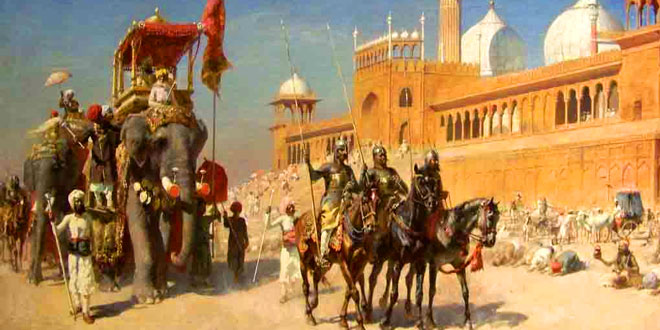Question: Describe Briefly the history of Independent State of Bengal.
Answer: The independent state of Bengal was founded by Murshid Kuli Khan. He was first appointed by the Mughal emperor as its diwan and later elevated to be its governor. Later, the region of Odisha was added to Bengal. Bengal prospered under him. He shifted his capital from Dhaka to Murshidabad. He owned allegiance to the Mughal emperor only in name.
After Kuli passed away in 1727 CE, his son-in-law Shujauddaulah became the next governor of Bengal. Bihar was also under his charge. Bengal was rich and prosperous state therefore, the first to be targeted and captured by the British.
Question: Describe how the Sikhs rose to power.
Answer: After the execution of the ninth Sikh guru, Guru Tegh Bahadur (1664-1675 CE) by Aurangzeb, the tenth guru, Guru Gobind Singh Ji (1675-1708 CE) transformed the Sikhs into a militant sect, the Khalsa in 1699 CE. Guru Gobind Singh ji led the Sikhs in several battles against the Mughals. After his death in 1708 Ce, the Sikhs continued their struggle against the Mughals under the leadership of Banda Bahadur. By 1720 CE, they had established their kingdom between the Sutlej and the Yamuna rivers. The Sikh struck their own coins and had their own administrative set up. Their army consisted of several well-trained compact units called misls. They collected taxes from the farmers in return for protection from the Mughal officials.
Though Mughals repeatedly tried, but could not put down the Sikhs. Under the rule of Maharaja Ranjit Singh, the Sikh Kingdom reached the height of its glory. It now extended from the rivers Indus to the Yamuna. Ranjit Singh established his capital at Lahore.
Question: Give an account of the administration of Shivaji.
Answer: Shivaji was good administrator. He looked after his territory well. Shivaji ruled his kingdom with the help of a council of eight ministers called Ashtapradhans. The most important of these eight ministers were the Peshwas or the prime ministers and the senapati or the commander of the army.
The main source of revenue for the Maratha governement was land revenue. Shivaji collected land tax from territories ruled directly by him. This amounted to two-fifths of the land’s produce. However, the peasants who lived in territories administered by the Mughals or other rulers also had to pay two taxes to the Marathas- Chauth and Sardeshmukhi- in addition to the tax they paid their own rulers. Chauth was one-fourth of the land revenue and was paid to ensure that the Marathas would not raid the lands of these peasants. Sardeshmukhi was an additional one-tenth of the land revenue which these farmers had to pay.
Question: Describe the rise of Maratha power under the Peshwas.
Answer: Bala Vishwanath (1713-1720 CE) was the first of a line of seven peshwas. He was an expert in administration and revenue collection. He got back from the Mughals the territories ruled by Shivaji and right to collect Chauth and Sardeshmukhi from the Mughal territories in the Deccan. The Peshwas soon became the real rulers of the Maratha Kingdom.
Baji Rao I (1720-1740 CE) was the second Peshwa. Under him the Marathas took control of Gujarat, raided Bengal and overran Malwa and Bundelkhand. They defeated Mughals near Delhi in 1737 CE. They also defeated Nizam of Hyderabad. Asaf Jah was forced to enter into a treaty with Marathas. Baji Rao, however, did not occupy the thorne.
Balaji Baji Rao (1740-1761 CE) was the eldest son of Baji Rao I. In 1750 CE he made Pune his capital. Under Balaji Baji Rao, the Maratha Kindom reached its greatest extent. Its fame and power reached their peak. Balaji Baji Rao captured Delhi in 1753 CE and Punjab in 1758 CE. The Mughal emperor entered into a treaty with the Marathas by which the Marathas agreed to defend Mughals from further invasions of Ahmad Shah Abdali. In return they gave Marathas right to collect to collect Chauth and sardeshmukhi from Punjab and Sind. This brought the Marathas great wealth. But it also earned them the anger of the Sikhs, the Rajputs and the kingdoms of Bengal and Hyderabad.
Question: What is the significance of 5 sacred symbols of the Sikhs?
Answer: Guru Gobind Singh asked all Sikh men to were five sacred symbols. these were:
- Kesha or hair – cutting or removing hair from any part of the body was not allowed as hair is a symbol of spirituality and signified surrender to god’s will.
- Kangha or comb – It is a symbol of cleanliness. Just as when we comb our hair, we take out the broken strands of hair, similarly we should comb out the bad thoughts from our mind.
- Kara or bracelet – It acts as a reminder to stop a person when he raises his hand to do anything wrong.
- Kaccha or underwear – It is a symbol of high moral character.
- Kirpan or dagger – It is to be used to defend the helpless and uphold the truth.
 Class Notes NCERT Solutions for CBSE Students
Class Notes NCERT Solutions for CBSE Students


